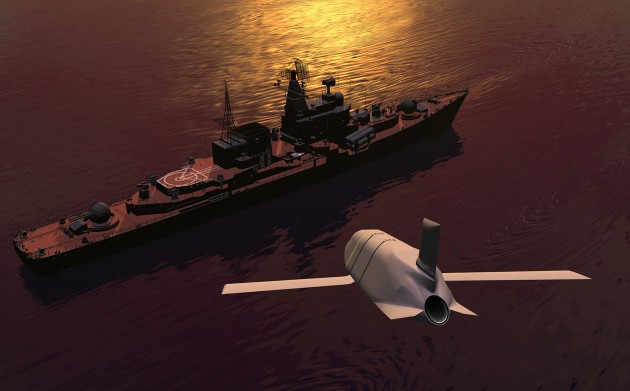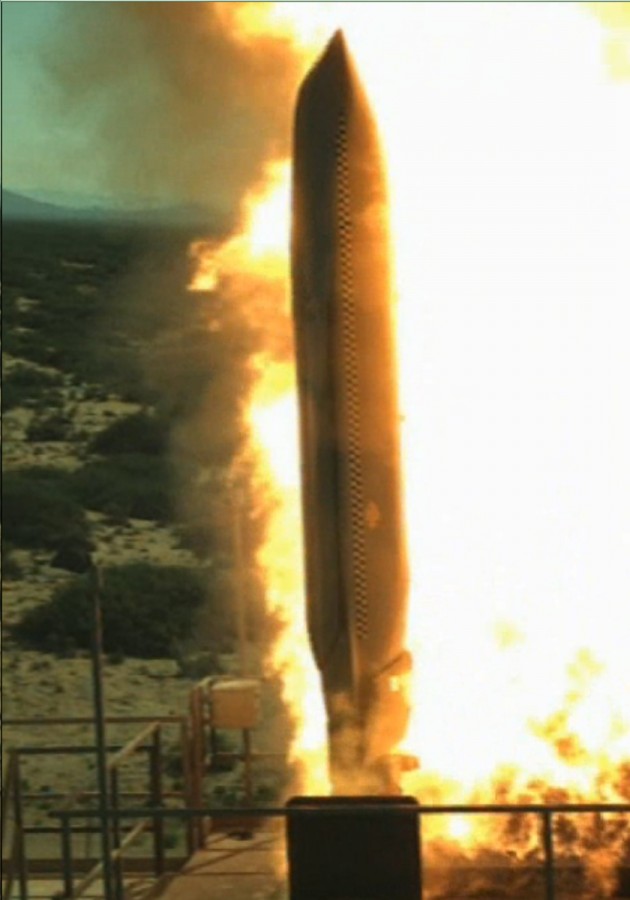Plugging AirSea Battle’s Hole: Lockheed Dishes $30M For Anti-Ship LRASM Test
Posted on

An artist’s depiction of a Lockheed Martin LRASM (Long-Range Anti-Ship Missile) hurtling towards its target.
NATIONAL HARBOR: We all know that, since the end of the Cold War, the US military has vastly expanded its ability to precisely strike targets on the land. The dirty secret is that we’ve unilaterally disarmed our capability to strike ships at sea.
The military calls this a “capability gap,” but it’s more like a gaping hole. Specifically, it’s a hole in the long-range arsenal required to wage a future “Air-Sea Battle” against an “anti-access/area denial” (A2/AD) defense-in-depth backed by a capable naval force like China’s.
“We need those capabilities,” a staffer from the interservice Air-Sea Battle Office told me. “We feel comfortable with our ability to address the current threat, [but] adversaries are creating weapons systems of increasing range and precision.” The AirSea Battle concept doesn’t depend on any one wonder weapon, he emphasized, but alongside tools like secure network datalinks, cyber/electronic warfare capabilities, a new stealth bomber, and a host of innovative tactics, “we do need a long-range anti-ship munition, and it needs to be a joint munition, in our opinion.”
So what are the Pentagon’s options to fill this gap? The leading one so far is Lockheed Martin’s Long-Range Anti-Ship Missile (LRASM), a derivative of the Air Force’s new JASSM-ER (Joint Air-to-Surface Standoff Missile – Extended Range). The Navy and DARPA have jointly funded LRASM, to the tune of $337 million so far — plus $30 million of Lockheed’s own money — and at least some factions of the Air Force are interested as well.
Recent developments in the LRASM program have strategic implications, not just technical and fiscal ones. On August 27, an Air Force B-1B conducted the first successful launch of a LRASM from an aircraft, hitting a moving ship “within a couple of feet” of the designated target point, said Lockheed’s vice-president for tactical missiles, Frank St. John. Just this morning, at the Air Force Association’s annual convention, St. John announced that LRASM passed a second and very different test only eight days later, on September 4th, when Lockheed successfully launched a LRASM from a Vertical Launch System cell.

September 4th’s successful LRASM launch from a Vertical Launch System (VLS) like those used on Navy ships.
The VLS cell used in September was on land, at the so-called Desert Ship test site at White Sands Missile Range, New Mexico. But it is a duplicate of the missile launcher used on scores of cruisers, destroyers, and submarines. Currently, VLS launchers can fire Tomahawk Land Attack Missiles (TLAMs) to hit targets ashore, Standard Missiles to hit enemy aircraft and even ballistic missiles, and Anti-Submarine Rockets (ASROCs) to sink enemy subs — but the Pentagon long ago phased out the only anti-ship weapon that could fit, the Tomahawk Anti-Ship Missile (TASM).
In fact, the military converted many TASMs into TLAMs. That made sense after the collapse of the Soviet fleet and the shift to striking land targets in Iraq, Afghanistan, and the Balkans, but it leaves the service flat-footed in the face of a growing Chinese surface fleet. Navy F-18 fighters can carry the Harpoon anti-ship missile, and Navy frigates once had Harpoon launchers as well, which might theoretically be reinstalled. But against the vast distances of the Pacific and enemies with long-range cruise missiles of their own, the Harpoon looks rather sad, with the latest version having a range “in excess of 97 nautical miles.”
By contrast, the Air Force JASSM-ER, on which LRASM is based, has a range greater than 500 nautical miles. When converting the land-attack JASSM-ER to the anti-ship LRASM, admitted St. John, “you’re going to lose some range when you add in the sensors and some other capabilities” needed to hit a moving ship, but it remains a long-range weapon.
The other big advantage of the LRASM/JASSM family is that they’re designed to operate in the face of enemy electronic warfare and find their target without relying on GPS. This is particularly challenging at sea, where almost every target is in constant motion. JASSM has what’s called “inertial navigation,” the ability to navigate to a pre-designated point without relying on GPS, but LRASM needs some way to find a moving target on its own, without any targeting assistance from spy satellites or drones whose signals the enemy can jam.
To do that, “the system has a passive RF [radio frequency] sensing capability where it will find and detect and steer the system towards the threat,” St. John told reporters. In fact, he claimed, “LRASM, once you launch it — unless you re-target it — is completely autonomous.”
So when will this weapon be ready? The LRASM program started in 2009, when DARPA picked up on a Pacific Fleet “urgent operational needs” request to fill the anti-ship gap. DARPA and the Navy have committed $337 million to date. But when DARPA funding was interrupted, Lockheed felt it urgent enough to conduct the VLS test that it spent $30 million of its own money to do so.
Part of Lockheed’s motivation to push ahead may have been the Navy’s decision to hold a competition for an “Offensive Anti-Surface Warfare Weapon” (OASuW) program, in which LRASM is not the only contender (though St. John dismissed the potential competitors as retreads of aging designs, unsuited for modern war). Congress appropriated $87 million for OASuW in fiscal 2013 for the Navy to start planning and writing an acquisition strategy.
“If the funding continues to flow,” St. John said, the first versions of the missile could enter service in 2018 — but that money has to be in the 2015 budget request that is in its final stages even now (albeit painfully overshadowed by the uncertainties of sequestration). “I’d say they’ve got about six to nine months to decide how they’re going to go or delay.”
The next step beyond aircraft- and surface ship-launched LRASMs is a submarine-launched version. There’s definite interest — “If you go look in the navy documentation you’ll see a road map to the sub-launched version,” St. John said — but so far all funding for such a variant has come from Lockheed itself.
One DARPA official told reporters recently that, once the basic challenges of launching from a VLS cell are solved, launching from a VLS that happens to be underwater will a relatively easy step.
“I think we’re pretty early in the evaluation of the submarine-launched [version],” St. John said this morning when asked about that assessment. “I hope it’s easier. The VLS canister environment is pretty demanding [in itself]. We’re early in evaluation, I don’t want to go as far as our customer might, [but] I hope they’re right.”
Subscribe to our newsletter
Promotions, new products and sales. Directly to your inbox.
